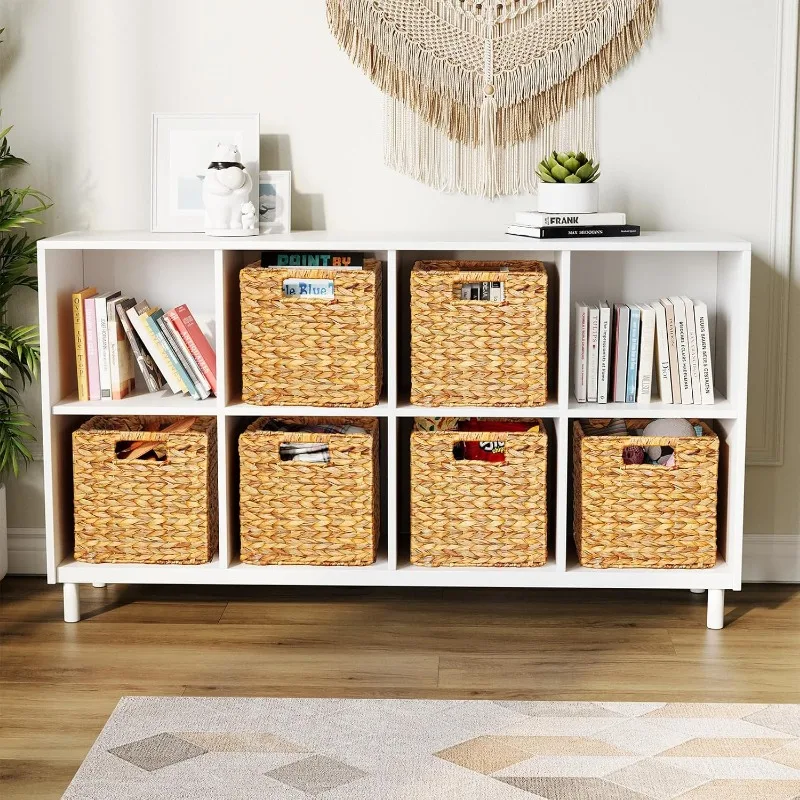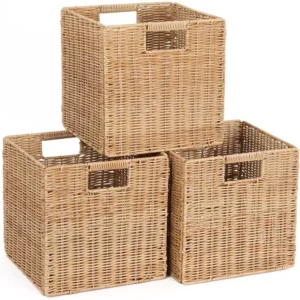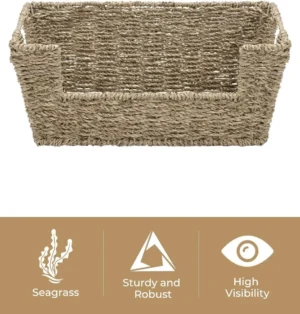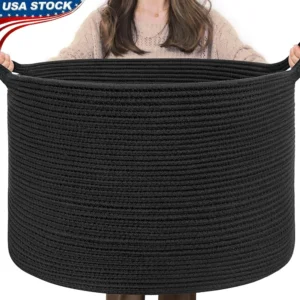Introduction: Understanding the Value of Basket Restoration
Old woven baskets carry stories from the past, representing craftsmanship that deserves to be preserved. Basket restoration goes far beyond simple cleaning—it’s about breathing new life into these functional pieces of art that may have been passed down through generations or discovered at estate sales and thrift stores.
The value of restoring woven baskets extends beyond mere sentiment. These versatile containers represent sustainable design that has stood the test of time. By restoring rather than replacing them, you preserve unique craftsmanship while extending their functional life for years to come.
At Tidy Treasure, we believe in combining beauty with functionality in every aspect of home organization. This philosophy extends perfectly to basket restoration, where the goal is to enhance both aesthetic appeal and practical use.
In this comprehensive guide, you’ll learn how to:
– Assess your basket’s condition and restoration potential
– Select the right tools and materials for the job
– Clean different basket materials safely
– Condition and revitalize brittle fibers
– Repair structural damage
– Preserve your restored basket for years of continued use
Many people discover that organizing laundry with wicker baskets becomes even more satisfying when using beautifully restored pieces with character and history. With proper techniques and a bit of patience, the transformation can be remarkable, especially when you understand how to clean wicker baskets properly as part of the restoration process.
Assessing Your Basket’s Condition and Restoration Potential
Before diving into restoration work, take time to carefully evaluate your basket’s condition and identify its materials. This assessment will guide your entire restoration approach.
First, determine what material your basket is made from:
- Wicker: A weaving technique rather than a material, often made from willow, reed, or rattan
- Rattan: Light-colored with a glossy surface and visible growth nodes
- Reed: Similar to rattan but with a more uniform appearance
- Cane: Thin strips usually used in chair seats and fine basket weaving
- Grass or straw: Lightweight with a distinctive natural scent
- Wood splint: Flat, thin strips of wood (often oak, ash, or maple)
Examining rattan baskets and wicker baskets in good condition can help you identify what your piece should look like when restored.
Next, evaluate the damage severity:
- Minor damage: Surface dirt, light staining, minor fraying, or slight loosening of weave
- Moderate damage: Broken strands, visible mildew, dry/brittle fibers, some structural warping
- Severe damage: Large holes, significant structural collapse, extensive mold, extremely brittle material
DIY restoration is most appropriate for minor to moderate damage. Consider professional restoration if your basket has historical or monetary value, or if it has severe structural issues that might worsen with amateur handling.
Material type significantly impacts your restoration approach. Reed and rattan can often withstand more moisture during cleaning than grass or straw baskets, which require gentler, drier methods.
Essential Tools and Materials for Basket Restoration
Gathering the right supplies before you begin ensures a smooth restoration process. Here’s what you’ll need:
Cleaning Supplies:
– Soft-bristled brushes (toothbrushes work well for detailed areas)
– Microfiber cloths
– Cotton swabs for hard-to-reach areas
– Mild soap (dish soap without additives)
– White vinegar
– Spray bottle
– Vacuum with soft brush attachment
Repair Tools:
– Sharp scissors
– Needle-nose pliers
– Measuring tape
– Awl or wooden skewer for weaving
– Small clamps or clothespins
– Toothpicks for applying adhesive
Adhesives:
– Wood glue (for structural repairs)
– PVA (polyvinyl acetate) craft glue
– White glue for minor fixes
Conditioning Materials:
– Boiled linseed oil (not raw)
– Mineral oil
– Small paintbrushes for application
Replacement Materials:
– Reed, cane, or splints that match your basket material
– Natural fiber cord for binding
Setting up a proper workspace is equally important. Choose a well-ventilated area with good lighting and protect your work surface with old towels or newspapers. Having examined different woven storage baskets, you’ll be better equipped to match materials and weaving patterns during repairs.
Step 1: Proper Cleaning Techniques for Different Basket Materials
Begin restoration with thorough cleaning, adapting your methods to suit your basket’s material and condition.
Dry Cleaning (First Step for All Baskets):
1. Start by gently vacuuming with a soft brush attachment to remove loose dirt and debris
2. Use soft brushes to loosen dirt from the weave
3. Reach tight spaces with cotton swabs
4. Continue until no loose dirt remains
Wet Cleaning (Material-Specific):
For reed, rattan, and sturdier wicker:
1. Mix a solution of warm water with a small amount of mild dish soap
2. Dampen (don’t soak) a cloth with the solution
3. Gently wipe surfaces, following the direction of the weave
4. Follow with a clean, damp cloth to remove soap residue
5. Dry immediately with clean towels
For delicate materials like grass, straw, or aged splint:
1. Use a barely damp cloth with minimal moisture
2. Test in an inconspicuous area first
3. Clean in small sections, drying immediately
4. Never submerge these materials
For Mold and Mildew:
1. Work outdoors if possible
2. Mix equal parts white vinegar and water
3. Apply sparingly with a cloth or soft brush
4. Let sit for 5-10 minutes
5. Wipe clean and dry thoroughly
Proper drying is critical to prevent warping and new mold growth. Place the basket in a well-ventilated area away from direct heat or sunlight. Rotate periodically to ensure even drying, which may take 24-48 hours depending on humidity levels.
If your basket gets wetter than intended during cleaning, reshape it gently while damp and maintain that shape as it dries. Understanding proper rattan basket storage techniques can help you apply similar principles during the drying process.

Step 2: Conditioning and Revitalizing Dry or Brittle Fibers
Over time, basket materials naturally lose moisture and oils, becoming brittle and prone to breaking. Conditioning restores flexibility and strength to these fibers, making subsequent repairs more successful.
Testing for Dryness:
Gently flex a small section of the basket. If you hear cracking sounds or see the material beginning to split rather than bend, conditioning is needed. Extremely brittle baskets might even shed small pieces when handled.
Conditioning Options:
For reed, rattan, and wooden materials:
1. Boiled linseed oil (thinned 50% with mineral spirits for better penetration)
2. Mineral oil (food-grade)
3. Commercial basket conditioners
For grass and more delicate materials:
1. Very diluted white glue solution (1 part glue to 10 parts water)
2. Light application of mineral oil
Application Technique:
1. Work in a well-ventilated area, as some oils have strong odors
2. Apply a small amount of conditioner using a soft cloth or brush
3. Work in the direction of the weave
4. Pay extra attention to particularly dry areas
5. Allow to penetrate for 15-30 minutes
6. Wipe away any excess with a clean cloth
7. Let dry completely (24-48 hours)
Avoid over-conditioning, which can make baskets sticky or attract dust. It’s better to apply multiple light coats than one heavy application. A properly conditioned basket will have a subtle sheen rather than a wet appearance and will feel slightly more flexible but not damp.
Many of the best laundry organization wicker baskets maintain their durability through regular conditioning, demonstrating how proper care extends basket life well beyond initial restoration.
Step 3: Repairing Structural Damage and Broken Elements
With your basket clean and conditioned, you’re ready to address structural damage. Different types of damage require specific repair approaches.
Reshaping Deformed Baskets:
1. Slightly dampen the basket with a fine water mist (avoid soaking)
2. Gently reshape by hand, working slowly
3. Place weights or supports to hold the desired shape
4. Allow to dry completely (24-48 hours)
Fixing Loose Weaves:
1. Identify where the weave has come undone
2. Carefully tuck loose ends back into the pattern
3. Secure with a tiny dab of PVA glue if needed
4. Use clothespins or small clamps to hold in place while drying
Repairing Broken Strands:
1. For clean breaks, apply small amount of wood glue to both ends
2. Press together firmly and wipe away excess glue
3. Secure with a wrap of waxed thread or thin wire until dry
4. For complex breaks, you may need to splice in new material
Mending Handles and Rims:
1. For minor cracks, apply wood glue and clamp until dry
2. For broken handles, reinforce from underneath with matching material
3. When working with wicker baskets with handles, pay special attention to stress points where the handle joins the main basket
Working with Replacement Materials:
1. Soak new reed or splint in water for 30 minutes to make it flexible
2. Cut to slightly longer than needed length
3. Weave following the existing pattern
4. Tuck ends securely and trim excess
5. Apply small dab of glue to secure ends if necessary
When inserting new material, match the original weaving pattern as closely as possible. Take photos before dismantling any section to use as reference. New materials will likely be lighter in color than the original, but will darken over time with use and exposure.

Step 4: Reinforcing Weak Areas to Prevent Future Damage
After addressing visible damage, take time to reinforce vulnerable areas to prevent future problems. This proactive step significantly extends your basket’s useful life.
Identifying Weak Points:
– Areas where the weave has started to loosen
– Thin spots in the base that bear weight
– Stress points where handles attach
– Rim sections that show early signs of unwinding
– Places where different weaving patterns meet
Base Reinforcement Techniques:
– For sagging bases, add discreet support with a fitted piece of thin cardboard covered with fabric
– Apply thin line of diluted PVA glue along the underside of loose bottom weaves
– Reinforce where base meets sides with invisible stitching using waxed thread
Handle Strengthening:
– Wrap thin, matching reed around stress points where handles join the basket
– Add a supportive understructure for heavy-duty baskets
– Apply small amounts of wood glue to loose connections
Side Wall Support:
– Tighten loose weaving by gently pushing strands closer together
– Secure with minimal glue where needed
– Add vertical support pieces in the same material if walls are collapsing
The goal of reinforcement is to add strength without changing appearance. Quality wicker storage baskets often incorporate these reinforcement techniques during manufacturing, providing excellent examples of how subtle strengthening can be both effective and visually appealing.
Finishing Touches: Subtle Enhancements for Aesthetics
With structural repairs complete, focus on refining the appearance of your restored basket while maintaining its authentic character and patina.
Surface Refinement:
– For rough edges, gently sand with very fine sandpaper (220 grit or higher)
– Work carefully in the direction of the weave
– Remove all dust with a soft brush before applying any finishes
Natural Protective Finishes:
– Clear paste wax provides subtle protection and gentle sheen
– Shellac (thinned 50% with denatured alcohol) adds more protection for frequently used baskets
– Beeswax polish enhances natural beauty while protecting
Color Considerations:
– In most cases, preserving the natural patina maintains the basket’s character and value
– For noticeable color differences in repaired areas, a light tea stain can help blend new materials
– Test any colorant on an inconspicuous area first
Final Adjustments:
– Trim any protruding fibers with sharp scissors
– Reshape one final time if needed
– Let new finishes cure completely before using the basket
The most successful restorations respect the basket’s age and history rather than trying to make it look brand new. A well-restored basket should look cared for but not artificially pristine, similar to how bedroom organization with woven baskets embraces natural textures and subtle variations.
Long-Term Care: Preserving Your Restored Basket
Your restoration work deserves protection through proper ongoing care. These maintenance practices will help your basket remain beautiful and functional for years to come.
Ideal Environmental Conditions:
– Store baskets in moderate humidity (40-60%)
– Avoid direct sunlight which can fade and dry out fibers
– Keep away from heat sources like radiators or fireplaces
– Provide adequate air circulation to prevent mold
Regular Maintenance:
– Dust weekly with a soft brush or cloth
– Inspect monthly for early signs of damage
– Apply conditioner every 6-12 months depending on climate and use
– Clean spills immediately to prevent staining
Proper Handling:
– Lift from the base, not the rim or handles
– Avoid overloading with heavy items
– Rotate baskets used for display to ensure even aging
Warning Signs That Indicate Maintenance is Needed:
– Squeaking sounds when handled
– Visible dryness or whitish appearance
– Loosening weave
– Musty odors
Seasonal Considerations:
– In winter, when indoor heating reduces humidity, consider more frequent conditioning
– In summer, watch for increased moisture and potential mold in humid climates
Knowing how to properly store baskets not in use is equally important for preservation, especially for seasonal or special-occasion baskets that aren’t displayed year-round.
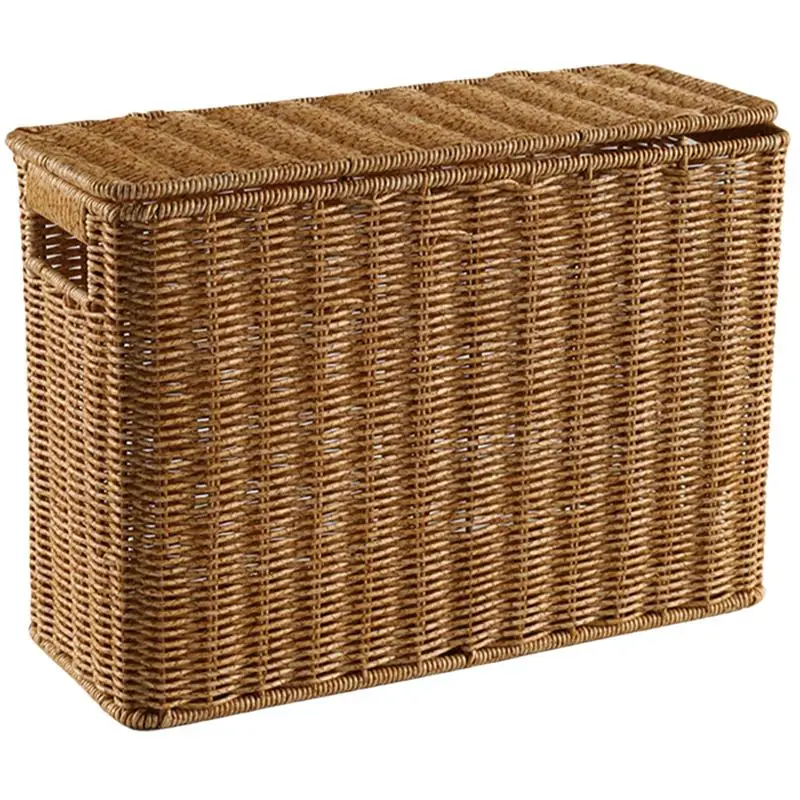
Common Challenges and Solutions in Basket Restoration
Even experienced restorers encounter challenges. Here are solutions to common problems you might face:
Problem: Persistent mold odor after cleaning
Solution: Place the basket in sunlight for 1-2 hours, then move to shade. Sprinkle baking soda inside, let sit overnight, and vacuum thoroughly. Repeat if needed.
Problem: Extremely brittle material that breaks during repair
Solution: Try a humidity chamber – place the basket in a bathroom with a hot shower running for 5 minutes to increase moisture absorption before attempting repairs. Work quickly while the material remains pliable.
Problem: Unusual materials that don’t respond to standard treatments
Solution: Research basket-making traditions from the basket’s culture of origin. Many indigenous techniques use material-specific treatments that modern approaches might overlook.
Problem: Color inconsistency after repairs
Solution: Strong tea, coffee, or natural dye baths can help blend new and old materials. Apply with a cotton swab only to the lighter areas for better control.
Problem: Previously repaired with inappropriate materials (tape, staples, wire)
Solution: Remove old repairs carefully with appropriate tools. Stabilize the area with temporary supports before applying proper restoration techniques.
Problem: Basket falls apart when wet during cleaning
Solution: Switch to minimal moisture methods using damp cloths rather than sprays. Clean small sections at a time, drying completely before moving on.
Effortless laundry organization with wicker baskets depends on baskets that maintain their structural integrity, making these solutions valuable for preserving both decorative and functional pieces.
Black Wicker Baskets, Rattan Storage Baskets, Tall Wicker Baskets, Wicker Shelf Baskets, Woven Storage Baskets
5-Tier Distressed Black Wood Frame Storage Tower with Removable Wicker Baskets for Home Organization$715.80 Select options This product has multiple variants. The options may be chosen on the product pageWicker Laundry Baskets, Woven Laundry Baskets, Woven Storage Baskets
$392.02 Select options This product has multiple variants. The options may be chosen on the product pageRattan Shelf Baskets, Rattan Storage Baskets, Small Wicker Baskets, Square Wicker Baskets
Square Plastic Wicker Storage Baskets Set of 3 with Collapsible Design for Cube Storage Organization$185.47 Select options This product has multiple variants. The options may be chosen on the product pageWicker Baskets with Handles, Wicker Storage Baskets, Woven Storage Baskets
$137.92 Select options This product has multiple variants. The options may be chosen on the product pageLarge Wicker Laundry Baskets, Tall Wicker Baskets, Woven Laundry Hampers, Woven Storage Baskets
$130.54 Select options This product has multiple variants. The options may be chosen on the product pageWicker Blanket Baskets, Woven Laundry Baskets
$89.60 Select options This product has multiple variants. The options may be chosen on the product page
When to Seek Professional Help for Valuable Baskets
While many baskets respond well to DIY restoration, some pieces warrant professional attention:
Indicators That a Basket May Be Particularly Valuable:
– Fine, complex weaving patterns
– Regional distinctive designs or techniques
– Age (pre-1940s)
– Maker’s marks or signatures
– Historical documentation of provenance
– Unusual size or shape for its type
Warning Signs That DIY Restoration Might Cause Damage:
– Significant historical or monetary value
– Extremely deteriorated condition
– Unique construction techniques you don’t understand
– Previous professional restoration work
– Materials you cannot identify with confidence
Finding Qualified Basket Restorers:
– Museum conservation departments can provide referrals
– Basket weaving guilds and associations
– Antique dealer recommendations
– Conservation organizations
Questions to Ask Professional Restorers:
– What is their experience with your specific basket type?
– Will they use historically accurate materials?
– How will they document their restoration process?
– What steps will they take to preserve original materials?
– What is their approach to visible repairs vs. invisible restoration?
Professional restoration typically costs more but may be necessary to preserve both the value and integrity of truly special pieces. For everyday storage needs, knowing different wicker laundry basket storage ideas can help you properly maintain your restored baskets in active use.
Conclusion: Enjoying Your Beautifully Restored Baskets
Restoring an old woven basket is more than a craft project—it’s an act of preservation that connects us to traditional skills and sustainable practices. Through patient cleaning, careful conditioning, thoughtful repair, and ongoing care, you’ve given new life to a functional piece of art.
Your restored basket now represents the perfect blend of beauty and functionality that we value at Tidy Treasure. Whether you use it for storage, organization, or display, it brings both practical value and visual warmth to your home.
These restored treasures often become favorites in the home, their character and history adding depth to your decor that new items simply cannot match. The skills you’ve learned through this restoration process will serve you well with future finds, building your confidence to rescue and revitalize other forgotten baskets.
We hope you’ll start your restoration journey with a basket that has been waiting for your attention. The transformation might surprise you, and the satisfaction of preserving these traditional crafts is truly remarkable.

